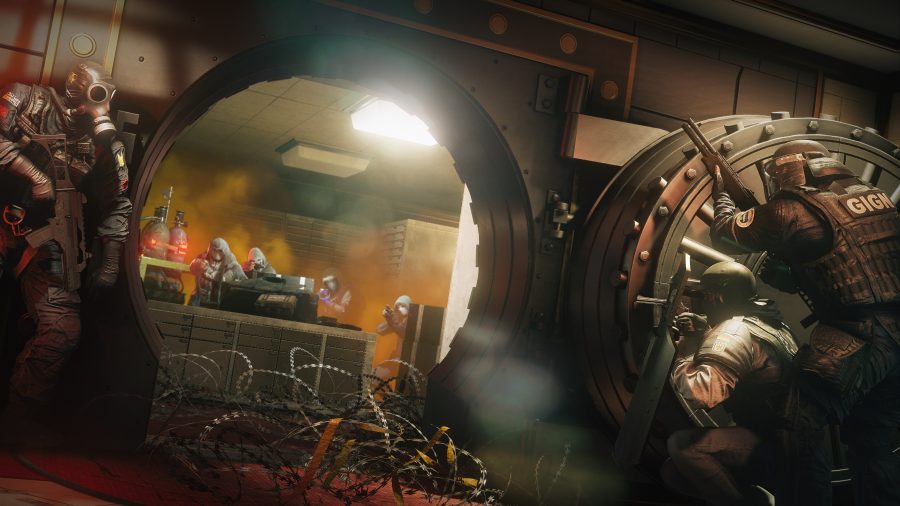It’s the dead of night as five soldiers of the Rainbow Six squad descend upon a suburban home. They have one mission: find the hostage. Standing in their way is a group of five terrorists held up in one of the rooms. Footsteps echo in the quiet as the mechanical sound of the terrorists reinforcing the fragile walls chimes in the air. Two soldiers rappel up the side of the house to the top floor while the other three plant a breach charge on the front door.
Breaching through the front door, the solders come under fire from a terrorist crouched on the stairway as the other soldiers flank from the top. Bullets break the silence, chunks of drywall flying through the air as the house turns into a war zone.
With many first person shooter series like “Call of Duty” looking to the not so distant future, the modern day shooter has become a scarcity among the gaming landscape. Luckily, “Rainbow Six Siege,” developed by Ubisoft Montreal, has you covered. A comeback of sorts, “Siege” has risen from the ashes of its cancelled predecessor, “Patriots,” offering fans the first installment in the dormant franchise since 2008. But really, “Siege” carries the “Rainbow Six” legacy in name alone, moving away from a co op campaign driven story to a competitive online multiplayer format.
Such a move is a calculated risk as it can potentially alienate the franchise’s current fan base without drawing the masses’s attention that flock around the “Call of Duty,” “Battlefield,” and “Halo.” Games often come under fire in today’s industry for being base models meant to sell countless downloadable content before the next sequel is pushed onto the shelves, and while “Siege” can be lacking in content at times, it offers something new and unique through its tactical often unforgiving gameplay and destructible environments.
Every bullet counts. Every trip wire, reinforced wall, or collapsable shield gives you a few more seconds of life and could be the deciding factor in who wins the match. Cooperation and communication with your squad is a must. From monitoring and tagging enemies on surveillance cameras to coordinating breaches, playing as a team is essential to winning. This isn’t a game designed for the lone wolf. Five member squads go up against each other in matches lasting between three and four rounds, where one team defends while the other attacks.
There are three game modes for multiplayer: bomb disarmament, hostage rescue and bio-container securement. Each of the modes play similarly with a few differences. For bomb disarmament, the defending team has to defend two locations versus one, and the hostage’s vulnerability affects how an attacking team handles a situation as one misplaced grenade throw can work in failure.
Players can purchase ten attack and defense operators using experience, called Renown, they earn through playing matches. Each of these defenders have different abilities and equipment such as placing tripwires, blowing through reinforced walls, dropping toxic gas or shooting grenades through walls. As only one player can be each operator, it’s important to coordinate who has what responsibilities during the round. Players can choose their load-outs and whether they want to use a shotgun or machine gun, a breach charge or stun grenade, C4 or barbed wire, but there’s not much in the way of customization.
Why is the game so addicting and fun to play? It’s the gameplay—the tense moments of dread as you slowly enter the bottom floor of a house with enemies potentially behind any corner—or laying in the floor, blasting a hole through the wall, and shooting enemies as they round their way up the stairs. Maybe, it’s the moments where you can throw a C4 charge out a window and detonate it in midair taking out two players. The destructibility creates a lived in world where you try to hide behind vanishing cover and get the drop on the enemy before they get the drop on you. Bullets in this game are deadly. A single shot can put you out of commission and regulate you to the sidelines.
There are 12 maps ranging from a suburban house to a large mansion estate to a downtown bank. While each map is fairly common and ordinary, the game plays with the expectations of what you might see in such environments. Coming across the blood-splattered walls of a silent hallway and finding the body of your dead teammates creates a visceral sense of loss and failure, as does the sound of footsteps upstairs when you’re the last player on the team. Sound plays an important function in the game offering audio clues to the location of the enemy and their traps. Sometimes a radio on a map might play static infused music, but mostly, the game’s silent until it’s not.
Outside of competitive multiplayer, “Rainbow Six Siege” brings back Terrorist Hunt from past games. In this mode, a squad of five teams together to complete objectives ranging from killing a number of computer controlled terrorists, rescuing hostages, defusing bombs or defending against waves of enemies. Each mode is fairly standard, but playing on the realistic difficulty setting turns easy completed objectives into an almost Herculean effort. The enemies overwhelm you by sheer numbers, and bullets remain just as deadly. The terrorists supporting explosive vests are particularly difficult and can take down half a squad if allowed to get too close.
Theoretically, you could play Terrorist Hunt by yourself, but “Siege” is meant to be played with others. The game also includes single player sections called Situations where players can test out the different operators by completing objectives.
“Rainbow Six Siege” is a little buggy and its game modes are similar, but it’s also fun and entertaining in ways most shooters lack. At times, it seems more like a proof of conception, an addicting proof of conception, mind you.
Creating a framework and a clear direction for the series, “Rainbow Six Siege” develops the base work for a future expanded sequel, with perhaps even a singe player campaign, but for what it’s worth, “Rainbow Six Siege” offers a different and thrilling spin on the multiplayer genre, even if it gets bogged down by repetitiveness and lack of content.







